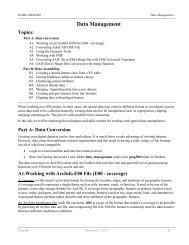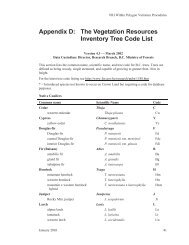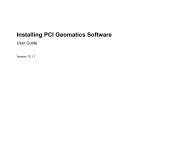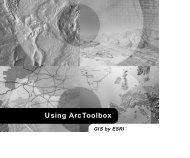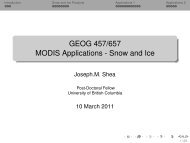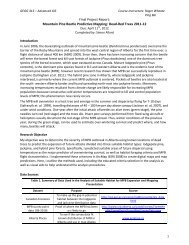Understanding Map Projections
Understanding Map Projections
Understanding Map Projections
You also want an ePaper? Increase the reach of your titles
YUMPU automatically turns print PDFs into web optimized ePapers that Google loves.
High Accuracy Reference Network<br />
A resurvey of NAD 1983 control points using GPS<br />
techniques. The resurvey date is often included as part of<br />
the datum name—NAD 1983 (1991) or NAD91.<br />
High Precision Geodetic (or GPS) Network<br />
A resurvey of NAD 1983 control points using GPS<br />
techniques. The resurvey date is often included as part of<br />
the datum name—NAD 1983 (1991) or NAD91.<br />
HPGN<br />
See High Precision Geodetic (or GPS) Network.<br />
Interrupted projection<br />
Discontinuities and gaps are added to a map to decrease<br />
the overall distortion. The world is divided, usually along<br />
certain meridians, into sections, or gores. Each section has<br />
its own projection origin.<br />
latitude<br />
The angular distance (usually measured in degrees) north<br />
or south of the equator. Lines of latitude are also called as<br />
parallels. See geodetic latitude and geocentric latitude.<br />
latitude of center<br />
The latitude value that defines the center (and sometimes<br />
origin) of a projection.<br />
latitude of origin<br />
The latitude value that defines the origin of the<br />
y-coordinate values for a projection.<br />
linear units<br />
The unit of measurement, often meters or feet, on a plane<br />
or a projected coordinate system. <strong>Map</strong> projection<br />
parameters such as the false easting and false northing are<br />
defined in linear units.<br />
longitude<br />
The angular distance (usually measured in degrees) east or<br />
west of a prime meridian.<br />
longitude of center<br />
The longitude value that defines the center (and<br />
sometimes origin) of a projection.<br />
longitude of origin<br />
The longitude value that defines the origin of the<br />
x-coordinate values for a projection.<br />
major axis<br />
The longer axis of an ellipse or spheroid.<br />
map projection<br />
A systematic conversion of locations from angular to<br />
planar coordinates.<br />
map scale<br />
The ratio of a length on a map to its length on the ground.<br />
meridian<br />
The reference line on the earth’s surface formed by the<br />
intersection of the surface with a plane passing through<br />
both poles. This line is identified by its longitude.<br />
Meridians run north–south between the poles.<br />
minor axis<br />
The shorter axis of an ellipse or spheroid.<br />
NAD 1927<br />
North American Datum of 1927. A local datum and<br />
geographic coordinate system used in North America.<br />
Replaced by NAD 1983. Also known as NAD27.<br />
NAD 1983<br />
North American Datum of 1983. A geocentric datum and<br />
geographic coordinate system used in North America. Also<br />
known as NAD83.<br />
oblate ellipsoid<br />
An ellipsoid created by rotating an ellipse around its minor<br />
axis.<br />
oblique aspect<br />
A planar or cylindrical projection with its central point<br />
located at some point not on the equator or at the poles.<br />
parallel<br />
A reference line on the earth’s surface that runs east–west<br />
around a sphere or spheroid and is parallel to the equator.<br />
Latitude lines are parallel circles.<br />
parameters<br />
Values that define a specific instance of a map projection.<br />
Parameters differ for each projection and can include<br />
central meridian, standard parallel, scale factor, or latitude<br />
of origin.<br />
Glossary • 103




